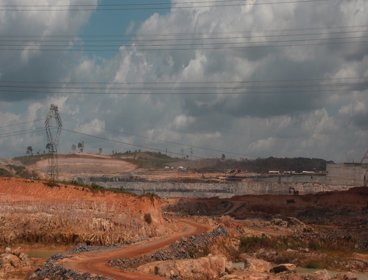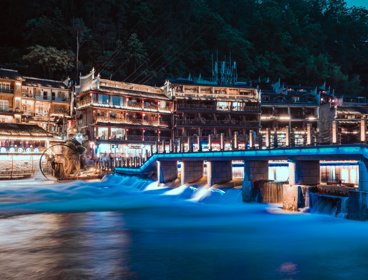April 2015
What and where is the Gilgel Gibe III dam?
The Gilgel Gibe III dam is the third in a series of five cascade hydroelectric power dams that have been proposed to be built along the River Omo. The river runs from the Shewan Highlands in central Ethiopia to Lake Turkana which straddles the Kenyan-Ethiopian border. Over 90% of the lake lies within Kenyan territory. Costing US$1.8 billion to build, the dam is due to be completed in mid-2015, with full power generation in place by the following year. Lake Turkana is currently the world’s largest lake found within a desert region and there are fears for its future as a means of sustaining both local economies and ecology.
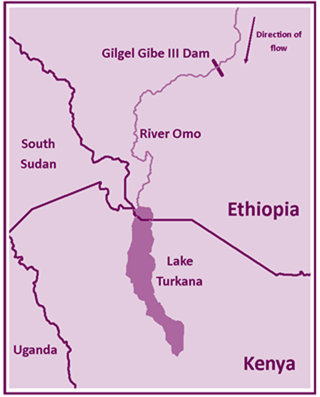
The location of the Gilgel Gibe III dam and Lake Turkana.
Why is the dam needed?
As part of the Gilgel Gibe series of dams, the developments will represent one of Africa’s largest hydroelectric power projects and will greatly increase Ethiopia’s potential to become domestically energy secure. The dam will have a 1870MW capacity, with half of this being used by Ethiopian residents and industries and the rest being sold to Kenya, Sudan and Djibouti, raising an estimated US$407 million a year for Ethiopia.
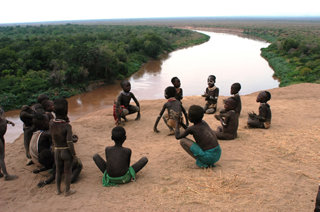
Ethiopian children playing above the Omo River. (Source: UNICEF Ethiopia)
The plans for the dam and its future sisters, Gibe IV and Gibe V (which are already in the final planning stages), have won the approval of both the Kenyan and Ethiopian governments for the amount of power they will generate for cities such as Nairobi and Addis Ababa. Advocates of the dam also insist that the construction will help regulate the flow of the river, allowing farmers further downstream to receive a more regular supply of water throughout the dry season. Ethiopia itself plans to use the reservoir storage as a means of irrigating an expanding set of sugar and cotton plantations.
There are also claims that the dam will reduce greatly the chance of the Omo river basin flooding. In 2006, devastating floods caused by heavy rains destroyed many hectares of valuable farmland and killed over 450 people, as well as leaving 20,000 people stranded.
What impacts will the dam have?
The potential reduction in the size of Lake Turkana continues to be of concern to Kenyans who inhabit the lake’s shoreline. The concrete Gilgel Gibe III dam will reach 243 metres high on completion and stretch to a length of 610 metres will create a reservoir 14 km3 in volume, a size which the dam’s critics will say will reduce the depth of Lake Turkana by at least 10 metres and reduce the flow into the lake by around 70%. Critics such as International Rivers have also noted that the method deployed to line the reservoir are not sufficient for the size of the dam and conservative estimates suggest that around 50% of water flow may be lost through leakage (International Rivers Network, 2011). The reduced flow into Lake Turkana is estimated to make at least half a million people who depend on it for their livelihood more vulnerable.
Reduced water levels firstly increase the chance of desertification in what is already an area prone to the negative effects of climate change. One’s capacity to fish in the lake will reduce and the size of the lake is such that a decrease in water level could also affect local rainfall patterns negatively. Ground water storage sources, which are fed by the lake, could come under greater stress up as farmers use them to irrigate crops and water their herds. Such is the predicted reduction in farming and fishing capacity around the lake that localised droughts and famines are also predicted (Vidal, J, 2015).
At least eight tribes are thought to border the lake, both on the Kenyan and Ethiopian sides, and many fear that tension caused as a result of the impact of the dam on water availability and their livelihoods may create conflicts over the border, especially between the Turkana and Rendille tribes.
“This place will turn into an endless, uncontrollable battlefield.”
Joseph Atach, Assistant Chief at Kanamkuny Village
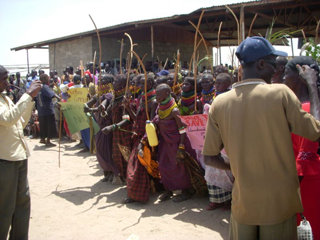
Turkana people protest against the construction of the Gibe III dam. (Source: International Rivers)
The lake ecosystem is also vulnerable. Already feeling the effects of climate change through reduced water levels, it is predicted that the construction of the Gilgel Gibe III dam will increase the salinity of the lake further as the water level drops. The acacia forest that borders Lake Turkana, partly in Sibiloi National Park to the north east is itself a source of grazing land for local nomadic pastoralists and relies on the seasonal low level flooding of the area to replenish nutrients and ground water stores. Though the dam authorities may see the risk of dangerous flooding as a reason to celebrate its creation, in fact no flooding may hamper the integrity of natural ecosystems and desertification could be the result.
Should Sibiloi National Park become more desert-like in habitat, one of the most important anthropological sites will also be threatened by desertification and soil erosion. Forming part of the ‘Cradle of Mankind’, this park was found to contain some of the earliest skeletons of early humans in the late 1960s and is now a UNESCO World Heritage Site.
The manner in which the dams have been commissioned has also been called into question; particularly in relation to consultation with the lake’s people, reports of violence against those who protested about the start of the dam’s construction and also the involvement of international financial support.
The Ethiopian government insist that their impact assessment of the dam has been thorough and that the lake’s people will benefit both from the controllable flow of the River Omo and the potential for them to be connected to an electrical grid in the future. Time will tell if the people of the Turkana region will be able to see these positive changes or if conflict at the Kenyan-Ethiopian border becomes the unwelcome outcome.
References
International Rivers Network (2011) Ethiopia’s Gibe 3 Dam: Sowing Hunger and Conflict Factsheet
Vidal, J. (2015) Ethiopia dam will turn Lake Turkana into 'endless battlefield', locals warn, The Guardian
Key Words
Dam
A barrier that holds back water within an aquatic system, often for the purpose of hydroelectric power generation and flood control.
Drought
A period of time over which an area of land experiences a much reduced water supply.
Famine
A period of time over which an area of land experiences a much reduced food supply.
Hydroelectric power
Energy that is produced by the gravitational force of water falling through a gradient for example through a turbine system in a dam.
Irrigation
The artificial watering of crops.
Nomadic pastoralists
Farmers who move from place to place with their cattle in order to make best use of seasonal grazing.
Lesson Ideas
Students can carry out a cost-benefit analysis on the impact of the Gibe III, making weighted consideration of the social, economic and environmental impacts. By comparing each other's results, students can discuss whether or not the dam should be allowed to go ahead.
Ask students to consider what additional measures may have to be in place to ensure that the Gilgel Gibe III dam can go ahead and that no one loses out from the plans. Then ask them to consider if the full range of their measures are possible to implement.
Through additional research, students can compare the scale of the Gilgel Gibe III dam with others that have already been completed and are up and running in other countries. Students can then assess the extent to which the concerns surrounding the new dam are justified based on the impact such dams have had in other areas.
Links
Updates on the progress of the Gibe III project
The Guardian report on the conflict
International Rivers work in Africa
File nameFiles
File type
Size
Download


